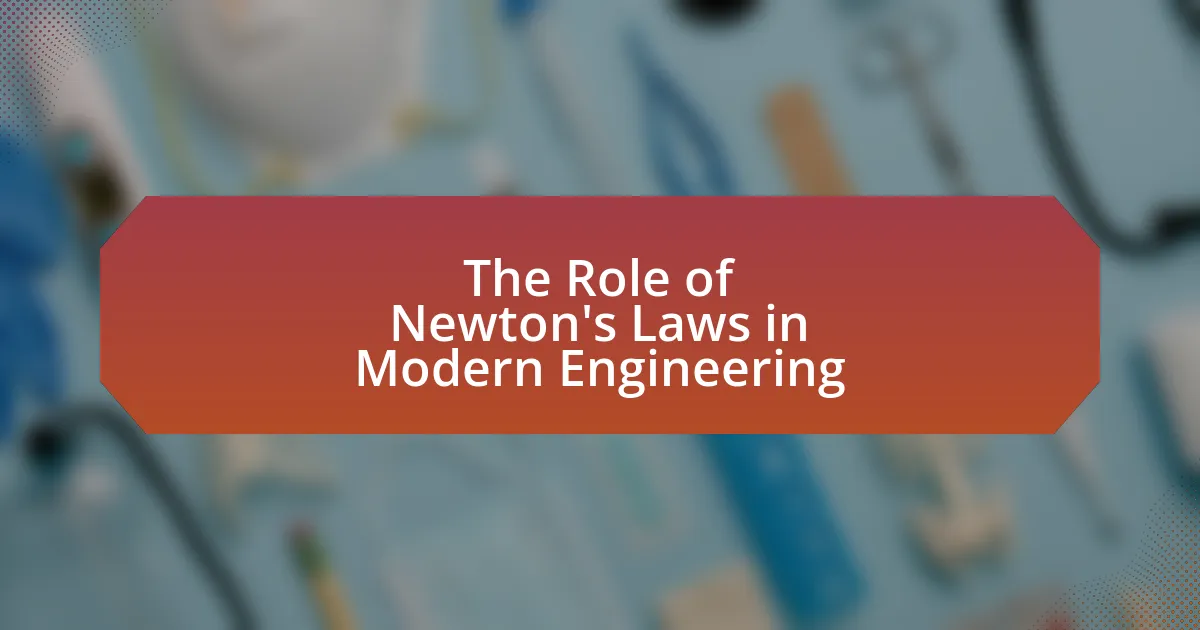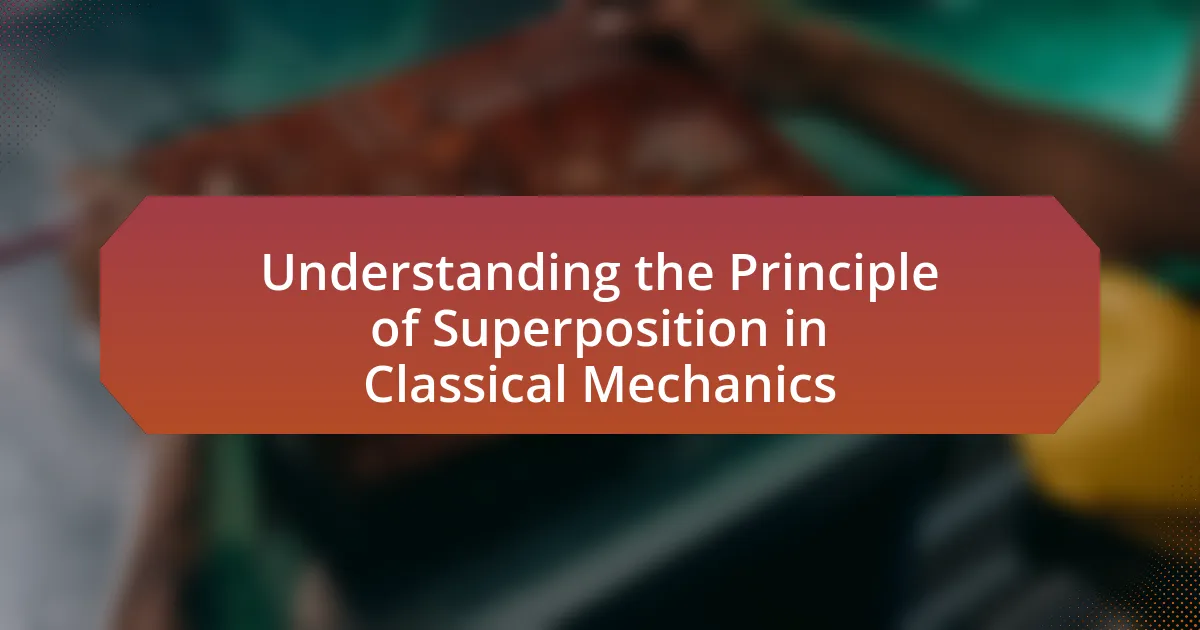Simple Harmonic Motion (SHM) is a fundamental type of periodic motion characterized by oscillations around an equilibrium position, where the restoring force is proportional to the displacement. This article explores the mechanics of SHM, detailing its definition, key characteristics, and the mathematical principles that govern it, such as Hooke’s Law. It highlights the significance of SHM in various real-world applications, including pendulum clocks, musical instruments, and automotive engineering, while also discussing the role of mass and elasticity in influencing oscillatory behavior. Additionally, the article outlines best practices for observing SHM and setting up experiments to demonstrate its principles effectively.

What is Simple Harmonic Motion?
Simple Harmonic Motion (SHM) is a type of periodic motion where an object oscillates around an equilibrium position, characterized by a restoring force proportional to the displacement from that position. This motion can be mathematically described by the equation x(t) = A cos(ωt + φ), where x is the displacement, A is the amplitude, ω is the angular frequency, and φ is the phase constant. SHM is fundamental in various physical systems, such as pendulums and springs, and is essential in understanding wave phenomena and vibrations in engineering applications.
How is Simple Harmonic Motion defined in physics?
Simple Harmonic Motion (SHM) is defined in physics as a type of periodic motion where an object oscillates around an equilibrium position, with the restoring force acting on the object being directly proportional to its displacement from that position and directed towards it. This relationship can be mathematically expressed by Hooke’s Law, which states that the force exerted by a spring is proportional to the distance it is stretched or compressed, represented as F = -kx, where F is the restoring force, k is the spring constant, and x is the displacement. SHM is characterized by its sinusoidal nature, meaning that the position of the oscillating object can be described by sine or cosine functions over time, leading to consistent frequency and amplitude in its motion.
What are the key characteristics of Simple Harmonic Motion?
Simple Harmonic Motion (SHM) is characterized by periodic oscillations where the restoring force is directly proportional to the displacement from an equilibrium position. This relationship can be mathematically expressed as F = -kx, where F is the restoring force, k is a constant, and x is the displacement.
Key characteristics of SHM include a constant frequency and amplitude, which means the motion repeats at regular intervals and the maximum displacement remains unchanged. Additionally, the motion is sinusoidal, indicating that the position of the oscillating object can be described by sine or cosine functions over time.
The energy in SHM is conserved, alternating between kinetic and potential forms, which is evident in systems like pendulums and springs. These characteristics are foundational in understanding various applications of SHM in everyday life, such as in clocks, musical instruments, and engineering systems.
How does Simple Harmonic Motion differ from other types of motion?
Simple Harmonic Motion (SHM) differs from other types of motion primarily due to its restoring force being directly proportional to the displacement from an equilibrium position, leading to oscillatory behavior. In SHM, the motion is periodic and sinusoidal, characterized by a constant frequency and amplitude, which is not the case in other motion types such as linear or projectile motion. For instance, in linear motion, the object moves in a straight line without oscillation, while in projectile motion, the path is parabolic and influenced by gravity, lacking the restoring force characteristic of SHM. This fundamental difference in the nature of forces and resulting motion patterns distinguishes SHM from other motion types.
What are the fundamental principles behind Simple Harmonic Motion?
The fundamental principles behind Simple Harmonic Motion (SHM) are based on the restoring force being directly proportional to the displacement from an equilibrium position and acting in the opposite direction. This relationship is mathematically expressed by Hooke’s Law, which states that the force exerted by a spring is proportional to its extension or compression, represented as F = -kx, where F is the restoring force, k is the spring constant, and x is the displacement.
In SHM, the motion is periodic, meaning it repeats at regular intervals, characterized by a constant frequency and amplitude. The total mechanical energy in SHM remains constant, as it oscillates between kinetic and potential energy. This principle is evident in systems like pendulums and mass-spring systems, where the motion can be described by sinusoidal functions, indicating that the position of the object varies with time in a predictable manner.
What role do restoring forces play in Simple Harmonic Motion?
Restoring forces are essential in Simple Harmonic Motion (SHM) as they act to bring a system back to its equilibrium position. In SHM, when an object is displaced from its equilibrium position, the restoring force, which is proportional to the displacement and acts in the opposite direction, causes the object to accelerate back toward equilibrium. This relationship is mathematically represented by Hooke’s Law, which states that the force exerted by a spring is directly proportional to the distance it is stretched or compressed, expressed as F = -kx, where F is the restoring force, k is the spring constant, and x is the displacement. This fundamental principle ensures that the motion is periodic and oscillatory, leading to the characteristic sinusoidal behavior observed in systems like pendulums and springs.
How does mass and elasticity influence Simple Harmonic Motion?
Mass and elasticity significantly influence Simple Harmonic Motion (SHM) by determining the system’s natural frequency and restoring force. In SHM, the mass of the object affects how quickly it accelerates in response to the restoring force, while elasticity, defined by Hooke’s Law, dictates the strength of that restoring force. Specifically, the natural frequency of a mass-spring system is given by the formula f = (1/2π)√(k/m), where k represents the spring constant (a measure of elasticity) and m is the mass. This relationship shows that an increase in mass results in a lower frequency of oscillation, while an increase in elasticity (higher k) leads to a higher frequency. Thus, both mass and elasticity are critical in shaping the behavior and characteristics of SHM.
Why is understanding Simple Harmonic Motion important?
Understanding Simple Harmonic Motion (SHM) is important because it forms the basis for analyzing various physical systems that exhibit periodic behavior. SHM is fundamental in fields such as engineering, physics, and even biology, as it describes the motion of pendulums, springs, and other oscillating systems. For instance, the principles of SHM are applied in designing clocks, musical instruments, and even in understanding molecular vibrations in chemistry. The mathematical models derived from SHM allow for precise predictions of motion, which is crucial for the development of technologies like seismographs and vibration analysis tools.
How does Simple Harmonic Motion relate to real-world applications?
Simple Harmonic Motion (SHM) is fundamental in various real-world applications, particularly in systems that exhibit periodic behavior. For instance, SHM principles are utilized in designing pendulum clocks, where the swinging motion of the pendulum is a classic example of SHM, ensuring accurate timekeeping. Additionally, SHM is crucial in engineering applications such as vibration analysis in mechanical systems, where understanding oscillations helps in minimizing unwanted vibrations in structures and machinery. Furthermore, in the field of acoustics, musical instruments rely on SHM to produce sound; for example, the strings of a guitar vibrate in SHM to create musical notes. These applications demonstrate the relevance of SHM in both everyday technology and scientific fields, highlighting its importance in understanding and designing systems that involve oscillatory motion.
What are the implications of Simple Harmonic Motion in engineering and design?
Simple Harmonic Motion (SHM) has significant implications in engineering and design, particularly in the development of systems that require precise oscillatory behavior. Engineers utilize the principles of SHM to design components such as springs, pendulums, and vibration isolators, which are essential in applications ranging from automotive suspension systems to seismic protection in buildings.
For instance, the design of a car’s suspension system relies on the characteristics of SHM to ensure a smooth ride by absorbing shocks and maintaining stability. Additionally, in civil engineering, structures are designed to withstand oscillations caused by earthquakes, using SHM principles to predict and mitigate potential damage.
The mathematical modeling of SHM allows engineers to calculate parameters like frequency, amplitude, and phase, which are crucial for optimizing performance and safety in mechanical systems. This application of SHM is validated by its widespread use in various engineering fields, demonstrating its foundational role in creating reliable and efficient designs.
How does Simple Harmonic Motion manifest in everyday life?
Simple Harmonic Motion (SHM) manifests in everyday life through various phenomena such as the swinging of a pendulum, the vibration of guitar strings, and the motion of springs. For instance, a pendulum clock operates on the principle of SHM, where the pendulum swings back and forth in a regular, periodic motion, maintaining a consistent timekeeping function. Similarly, when a guitar string is plucked, it vibrates in SHM, producing sound waves that create musical notes. Additionally, the compression and extension of springs in devices like mattresses or car suspensions exemplify SHM, as they return to their equilibrium position after being displaced. These examples illustrate how SHM is integral to the functioning of various mechanical systems and natural occurrences in our daily lives.
What are some common examples of Simple Harmonic Motion in daily activities?
Common examples of Simple Harmonic Motion (SHM) in daily activities include a swinging pendulum, a mass on a spring, and the vibrations of a guitar string. A swinging pendulum exhibits SHM as it moves back and forth around its equilibrium position, with the restoring force proportional to the displacement from that position. Similarly, a mass attached to a spring compresses and stretches, demonstrating SHM as it oscillates around its rest position. The vibrations of a guitar string when plucked also represent SHM, as the string moves up and down in a periodic manner, producing sound waves. These examples illustrate the principles of SHM in familiar contexts.
How do pendulums illustrate Simple Harmonic Motion in clocks?
Pendulums illustrate Simple Harmonic Motion (SHM) in clocks by swinging back and forth in a periodic manner, where the restoring force is proportional to the displacement from the equilibrium position. This motion occurs because gravity acts on the pendulum, pulling it back toward its resting position, resulting in a sinusoidal oscillation. The time period of a pendulum is determined by its length and the acceleration due to gravity, following the formula T = 2π√(L/g), where T is the period, L is the length of the pendulum, and g is the acceleration due to gravity. This relationship confirms that pendulums exhibit SHM, as their motion can be accurately predicted and measured, making them effective timekeeping mechanisms in clocks.
What role does Simple Harmonic Motion play in musical instruments?
Simple Harmonic Motion (SHM) is fundamental in the functioning of musical instruments, as it describes the oscillatory motion of vibrating strings, air columns, and membranes that produce sound. In string instruments like violins and guitars, the strings vibrate in SHM, creating sound waves that correspond to musical notes. Similarly, in wind instruments, the air column inside the instrument oscillates in SHM, generating sound through variations in pressure and frequency. The relationship between frequency and tension in strings, as described by the formula f = (1/2L)√(T/μ), illustrates how SHM principles govern pitch and tone. Thus, SHM is essential for sound production and the musical characteristics of various instruments.
What technologies utilize the principles of Simple Harmonic Motion?
Technologies that utilize the principles of Simple Harmonic Motion include pendulum clocks, mass-spring systems, and vibration sensors. Pendulum clocks operate based on the regular oscillation of a weight, demonstrating predictable timekeeping through simple harmonic motion. Mass-spring systems, commonly found in mechanical devices and engineering applications, exhibit oscillatory behavior when a mass is attached to a spring, allowing for energy storage and transfer. Vibration sensors, used in various industries for monitoring and analysis, rely on the principles of simple harmonic motion to detect and measure vibrations accurately. These technologies exemplify the practical applications of simple harmonic motion in everyday life.
How are seismic waves related to Simple Harmonic Motion?
Seismic waves are related to Simple Harmonic Motion (SHM) because both involve oscillatory motion characterized by a restoring force proportional to the displacement from an equilibrium position. Seismic waves, such as P-waves and S-waves, propagate through the Earth as vibrations caused by tectonic movements, exhibiting periodic motion similar to that of a mass-spring system in SHM. The mathematical description of seismic waves can be modeled using sinusoidal functions, which are fundamental to SHM, demonstrating that the principles governing their motion are fundamentally the same. This relationship is evident in the way seismic waves can be analyzed using the same equations that describe SHM, such as those involving frequency, amplitude, and phase.
What applications of Simple Harmonic Motion exist in automotive engineering?
Simple Harmonic Motion (SHM) is utilized in automotive engineering primarily in the design of suspension systems. These systems rely on SHM principles to absorb shocks and maintain vehicle stability during motion. For instance, the oscillation of springs in a vehicle’s suspension can be modeled as SHM, allowing for effective damping of road irregularities. This application enhances ride comfort and handling by ensuring that the vehicle’s body remains stable while the wheels adapt to the terrain. The effectiveness of SHM in suspension design is evidenced by its widespread use in various vehicle types, from passenger cars to heavy trucks, demonstrating its critical role in automotive engineering.
What are the best practices for observing Simple Harmonic Motion?
The best practices for observing Simple Harmonic Motion (SHM) include using precise measurement tools, ensuring a controlled environment, and selecting appropriate systems for observation. Precise measurement tools, such as high-speed cameras or motion sensors, allow for accurate tracking of oscillation parameters like amplitude and period. A controlled environment minimizes external factors, such as air resistance and friction, which can affect the motion. Additionally, selecting systems like pendulums or mass-spring systems, which are classic examples of SHM, provides clear and observable oscillatory behavior. These practices enhance the reliability of observations and ensure that the principles of SHM are accurately demonstrated and analyzed.
How can one set up experiments to demonstrate Simple Harmonic Motion?
To set up experiments demonstrating Simple Harmonic Motion (SHM), one can use a mass-spring system or a pendulum. In a mass-spring system, attach a mass to a spring and stretch the spring, then release it to observe oscillations. The motion will follow SHM principles, characterized by a restoring force proportional to the displacement from the equilibrium position. In a pendulum experiment, suspend a weight from a fixed point and displace it from its rest position, then release it to observe periodic motion. Both setups illustrate the key features of SHM, such as constant frequency and amplitude, confirming the theoretical framework of SHM as described by Hooke’s Law and the principles of gravitational force.
What tools are essential for studying Simple Harmonic Motion effectively?
Essential tools for studying Simple Harmonic Motion effectively include a mass-spring system, a pendulum setup, and a data acquisition system. A mass-spring system allows for the observation of oscillatory motion, while a pendulum setup demonstrates the principles of periodic motion. A data acquisition system, such as a computer with sensors, enables precise measurement of variables like displacement, velocity, and acceleration, which are crucial for analyzing the motion. These tools facilitate hands-on experimentation and data collection, reinforcing theoretical concepts in Simple Harmonic Motion.




